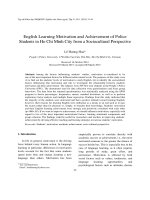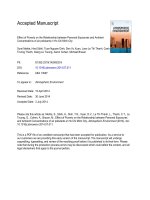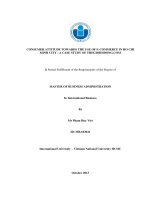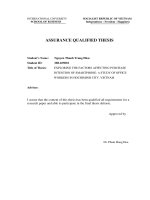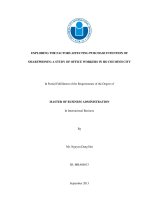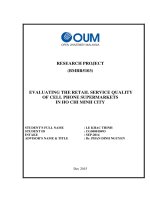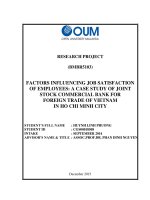Factors affecting organizational commitment and retention of key employees in small and medium sized firms in ho chi minh city
Bạn đang xem bản rút gọn của tài liệu. Xem và tải ngay bản đầy đủ của tài liệu tại đây (411.59 KB, 72 trang )
UNIVERSITY OF ECONOMICS HO CHI MINH CITY
International School of Business
------------------------------
PHAM THUY THUY DUNG
FACTORS AFFECTING ORGANIZATIONAL
COMMITMENT AND RETENTION OF KEY
EMPLOYEES IN SMALL AND MEDIUM SIZED
FIRMS IN HO CHI MINH CITY.
MASTER OF BUSINESS (Honours)
Ho Chi Minh City - 2014
UNIVERSITY OF ECONOMICS HO CHI MINH CITY
International School of Business
------------------------------
PHAM THUY THUY DUNG
FACTORS AFFECTING ORGANIZATIONAL
COMMITMENT AND RETENTION OF KEY
EMPLOYEES IN SMALL AND MEDIUM SIZED FIRMS
IN HO CHI MINH CITY.
ID: 21110009
MASTER OF BUSINESS (Honours)
SUPERVISOR: DR. DINH THAI HOANG
Ho Chi Minh City – 2014
TABLE OF CONTENT
ABSTRACT……………………………………………………………………………….….1
CHAPTER 1: INTRODUCTION
1.1 Research background and problem statement...................................................................... 2
1.2 Research objectives.............................................................................................................. 4
1.3 Research scope ..................................................................................................................... 4
1.4 Significance of the study ...................................................................................................... 4
1.5 Research structure ................................................................................................................ 5
1.6 Summary .............................................................................................................................. 6
CHAPTER 2: LITERATURE REVIEW
2.1Introduction ........................................................................................................................... 7
2.2Definition .............................................................................................................................. 7
2.3Previous Studies .................................................................................................................... 9
2.4Research Model .................................................................................................................. 15
2.5 Summary. .......................................................................................................................... 16
CHAPTER 3: RESEARCH METHODOLOGY
3.1 Sample................................................................................................................................ 17
3.2 Data Collection and Procedure .......................................................................................... 18
3.3 Question Design ................................................................................................................. 31
3.4 Data analysis method ......................................................................................................... 24
3.5 Summary ............................................................................................................................ 24
CHAPTER 4: DATA ANALYSIS
4.1 Respondent’s Demographics ............................................................................................. 26
4.2 Reliability Analysis............................................................................................................ 27
4.3 Exploratory Factor Analysis .............................................................................................. 29
4.4.5 Regression Analysis ........................................................................................................ 32
CHAPTER 5: CONCLUSION, IMPLICATIONS AND LIMITATIONS.
5.1 Conclusion ......................................................................................................................... 41
5.2 Managerial implications..................................................................................................... 41
5.2 Limitation and future research ........................................................................................... 43
REFERENCES....................................................................................................................... 45
APPENDICES…………………………………………………………................ ……….. 50
LIST OF FIGURES
Figure 2.1: Research Model………………………………………………….……..….16
Figure 3.1: Research Process……………………………………… …………………...19
LIST OF TABLES
Table 3.1. Source of data collection………………………………………….……….….20
Table 4.1: Demography Sampling……………………………………………………….27
Table 4.2 Reliability Test Results…………………………………………………..……28
Table 4.3 KMO and Bartlett’s Test of Independent Variables…………………………..30
Table 4.4 Rotated Component Matrix of Independent Variables……………………….31
Table 4.5 KMO and Bartlett’s Test of Dependent Variables………………… ………. 31
Table 4.6 Rotated Component Matrix of Dependent Variables…………..……………..32
Table 4.7 Correlation matrix…………………………..…………………………………34
Table 4.8 Model Summary of multiple regression analysis………………..……………35
Table 4.9 ANOVA of multiple regression………………………………………………35
Table 4.10 Coefficients of multiple regression analysis……………………………….36
Table 4.11 Model Summary of Simple Regression Analysis……………………..….…38
Table 4.12 ANOVA of Simple Regression Analysis……………………………………38
Table 4.13 Coefficients of Simple Regression Analysis………………...………………39
Table 4.14 Summary of testing hypotheses result……………………………………….40
ACKNOWLEDGEMENTS
First at all, I would like to express my sincere gratitude to my supervisor,
Dr. Dinh Thai Hoang for his continuous support in the throughout process of my thesis.
I would like to take this opportunity to thank leaders, professors and staffs at ISB
who have helped me during my two year master course.
My sincere thanks also go to the friends and colleagues at Bach Viet JSC, that
participated in the initial trial survey stages that led to the development of the final survey
questionnaire and their support over the time when I was busy to study.
Last but not least, I would like to grant special thanks to my family members who
have loved and supported me all over the time.
Ho Chi Minh City, July 4, 2014
Pham Thuy Thuy Dung
ABSTRACT
Retaining of key employees is one of the most important current matters of
human resource management. Employee’s turnover is a major threat to sustainability
and development of organizations. The problem is being faced by different
organizations around the countries. Intent to stay of key employee is one of the main
factors that could help reinforce the labor force and achieve the targeted goal.
This study examines the retention of key employees; its benefits and factors that
may help to retain the best employees of the organization.
Questions with five-point Likert scale are used to the research for investigating
the needs of core employees. Base on the previous research, the most affective factors
among of factors: training and career opportunities; job characteristics, and work/life
policies will be considered.
The research findings prove significant relationship of training and career
opportunities; job characteristics, and work/life policies that affect the staying decision
of core employees. This study will help SMEs in HCMC to find out various human
resource policies and to revise their current policies for further improvements.
1
CHAPTER 1: INTRODUCTION
1.1 Research Background and Problem Statement
Small and medium sized companies (SMEs) are important to almost all economies
in the world. SMEs are main element in all economics, in Europe, there are 57 per cent
of 1- person enterprises, 34 per cent of micro enterprises (less than 10 employees); 7.7
per cent of small enterprises; 1per cent of medium, totally of SME is 99.7 per cent but
there are only 0.27 per cent of large companies and 0.03 per cent of Stock Exchange
(Agnès, 2010). SMEs in China account for 99.9 percent of the total number of firms,
they provide 84 percent of total employment and account for 71 percent of total sales
(Qimiao, 2003). General Statistics Office (2012) reported SMEs are approximately 97
per cent of 448.393 companies in Vietnam and they represent the main drivers in
obtaining employment and VCCI (2012) reported SMEs contribute 60 percent GDP in
Vietnam with the capital of 6 million billion VND.
Although there is many important SME's distribution, they still face to many problems
in HR, the demand of the human resource is increasing and the lack of the right person,
especially in the management personnel, prevents the SMEs from development. One of
the specifications of HR in SMEs is not clearly function between administration and
human resource such as administration usually is responsibility for recruitment
function in SMEs, but that are 2 different functions of HR in the organization (Torben.,
2003). SMEs are very hard to compare with other organization type to attract qualified
employees because there are not clear policies to keep them. Recruitment firm Jobs
Factory, which polled over 4,500 students, revealed that in this year’s survey, the top
five employers of choice in the private sector are Apple, Singapore Airlines, Google,
3M and DBS Bank – all large companies with operations across the world. It is not
difficult to see why job seekers flock to Multinational Companies (MNCs). Besides the
easily recognizable brand names, they are also seen as organizations that are more
transparent, offer higher remuneration, superior benefits and strong organizational
structure – all of which point to better career prospects.
2
Recent surveys have highlighted that work-life balance is important to the
younger generation, and bigger firms are perceived to be more flexible – or at least,
more open to suggestion – in these areas. Conversely, SMEs are often seen to be nontransparent, authoritarian, and less professional. More often than not, the founder/boss’
inner circle is made up of family and relatives, with competence a secondary
consideration. (Developing an Argument, 2010)
Employee retention is considered the greatest challenge for businesses in
Vietnam and becomes a hot topic for discussions of human resource managers.
Vietnamese employees aggressively accelerate their career to better positions,
challenging jobs and better pay. In a survey of Navigos Group, the leading and largest
executive recruitment solution provider reported in Vietnam Plus (2010) “63,8 percent
of respondents from 168 companies operating in Vietnam including foreign-invested
ones ranked the employee retention as the number one human resource challenge in
2010”. And it also confirmed “getting the right people into the right job with the right
skills and to have them stay and grow are missions which will keep human resource
personnel busy in 2010. As long as this is the fact, employee retention is hard work.”
According to Towers Watson (2011) in a briefing of engagement indicator
survey, Vietnam labor market has experienced a talent war in which Vietnamese
employers are trying to engage their talent through some employee engagement
programs. In the Towers Watson’s data, it also showed that “employee engagement
levels in Vietnam have remained steady over the last five years (currently 78%
favorable) and higher than employee engagement levels in the overall Asia Pacific
Region (currently 74% favorable). However, employee intent to continue working for
their current companies is lower in Vietnam (54%) compared to Asia Pacific (61%). In
other words, the war for talent is fiercer in Vietnam than elsewhere in Asia Pacific
because employees are at higher risk of leaving.”
It is clear that organizational commitment has become one of the big matters to
human resource managers and employers in organizations in general and small and
medium sized organizations in particular today in Vietnam. It is also the role of HR
3
managers and employers to understand what are the critical factors affecting
employees to get their higher commitment to the company. Employee working life in
SMEs is short; most of employees think SMEs is temporary place, so they do not have
any long-term plan for the SME. The other specification of employees in SMEs is that
they are dependent on working, always waiting direction from leader. Based on that,
the employers at small and medium sized companies in Vietnam should come up with
strategic action plans to engage their employees into the sustainability of the
organization. These requirements from the reality are important to the employers to
find out what factors are affecting organizational commitment and intent to stay of key
employees in small and medium sized firms in Ho Chi Minh City.
1.2 Research objectives
In the thesis, we will review related theories and previous researches on factors
that have impact on the organizational commitment of employees in SMEs. Besides,
this study will find out what factors are affecting the retention of key employees and
measure how deep the influencing factors effect organizational commitment and
retention of key employees in SMEs.
1.3
Research Scope
The research was conducted in Ho Chi Minh City, a commercial and
financial trading center of Vietnam. Ho Chi Minh City has been chosen for this
research due to its centricity for Economic and Industrial activities and being a silicon
valley for many other activities (such as culture, education, sport) in which also
gathers the largest number of small and medium enterprises in the country.
This study focuses on small and medium sized enterprises in the area of Ho Chi
Minh City.
1.4 Significance of the study
HCMC is the biggest trading, financial and service center of Vietnam. There are
over 170.000 SMEs, among of 38 per cent of SMEs in Vietnam (HCMC Department of
Planning and Investment, 2012). SMEs in HCMC are very flexible so they not only
4
achieve the best result but also get bad influence with any negative chances. According
to the Ho Chi Minh City department of planning and investment, there are many
companies among 26.324 companies that quit in 6 months in the beginning of 2012
facing difficult situation in retaining their talent employees. Because of the importance
of key employees, this research focuses on retention key employees in SMEs in HCMC.
In general, key employees are normal employees with some special specification such
as working period, their importance in organizations,... So besides normal desires as
normal employees, they also need more request and to meet their demand. They are key
things to retain them in organizations.
1.5 Research Structure
The study consists of five main parts:
Introduction: Research background, problem statement, research purposes, scope of
study and significances of the study
Literature review: Some relative concept and definition of the study will be explained
in this chapter such as small and medium firms, key employees, key employee
retention as well as review of previous study about training and career opportunities;
job characteristics, and work/life policy; organizational commitment and retention of
employee. Proposal research hypotheses will be introduced in this chapter.
Methodology: Research process will be introduced in this chapter. This chapter also
introduces the methodologies of questionnaire design, measure of variable, draft
questionnaire, pilot study as well as the way to collect data and methodologies of data
analysis.
Data analysis: Collected data will be analyzed in this chapter.
Conclusion, implications and limitation: This is the result of the study distribution of
study for theory and applied, the limitation of the study and suggest to later study
5
1.6
Summary
This chapter provides the background of the study, statement of the
problem, research purposes of the study, and previous theoretical framework. It
also represents the scope and the structure of this study.
6
CHAPTER 2: LITERATURE REVIEW
2.1 Introduction
There are many previous studies for the factors that affecting organizational
commitment and retention of key employees in the world. In this chapter, the definition
of key (core) employee, SMEs, key employee retention and the factors affecting
organizational commitment and retention of key employees are introduced. Hypotheses,
research model are showed in this chapter.
2.2 Definition
2.2.1 Small and Medium Sized Firms
That is synonymous definition between small and medium firms and small and
medium sized enterprises. The abbreviation "SME" for small and medium sized
companies is used in the European Union and by international organizations such as the
World Bank (WB), and World Trade Organization (WTO). The term "small and
medium businesses" (or SMBs) is mainly used in the USA. Wikipedia (2012) defined
that there are the companies whose personnel number fall below certain limit. The
certain limits are different from the countries. The EC definite SMEs are three broad
parameters which define SMEs: micro-entities are companies with up to 10 employees;
small companies employ up to 50 workers, whilst medium-sized enterprises have up to
250 employees. In Vietnam, Decree No. 56/2009/ND-CP dated 30/6/2009 of the
Government defined SMEs are the organizations that are less than 200 employees or
capital less than 100 billion Vietnam Dong.
2.2.2 Key employees.
Key employees are permanent employees comprising the central and
foundational group that provides the skills essential to the survival and growth of an
organization. Core employees are supported in their work by contingent or peripheral
employees. (Business Dictionary) Critical job functions will be retained by small group,
relatively permanent "core" of employees with board skill allowing them to tackle a
7
variety of jobs (Janet, 2004). As definition from Renee (2012) a core employee is a fulltime attendance. Key employees are usually required to work at least 40 hours per
week. Key employees are necessary for business to function. Definition of key or core
employee in the research is person who works full time (Renee, 2012), they are the
persons who respond multi job and affect on other persons (Janet, 2004) and work for
organization more than 6 months.
2.2.3 Retention of key employees.
Once a SME finds an employee, it's very hard to find knowledgeable people who
are suitable to expected position because of some disadvantage of SMEs. Hiring
knowledgeable people for the job is essential for an employer. However, retention is
even more important than hiring. In order to keep employees motivated and willing to
stay with the organization, the company does not only pay more but also make
motivation working environment. Harvard Manage Mentor Journal (2012) said Core
employee retention is to keep that people who will help the organization remain
competitive to competitors in the market. In the other hand, when key employee leaves,
the organization will lose many things: the turnover is high so the cost of turnover
(including hiring costs, training costs and productivity loss) is high; When an employee
leaves, valuable knowledge about the company, customers, current projects and past
history will go with him, employer must pay much time and money has been spent on
the employee in expectation of a future return. When the employee leaves, the
investment is not realized; customers and clients do business with a company in part
because of the employee. When an employee leaves, the relationships that employee
built for the company are severed, which could lead to potential customer loss. When
an employee terminates, the effect is felt throughout the organization. Co-workers are
often required to pick up the slack. The unspoken negativity often intensifies for the
remaining staff. Higher retention rates motivate potential employees to join the
organization. If an employee resigns, then good amount of time is lost in hiring a new
employee and then training him/her and this goes to the loss of the company directly.
Moreover, even after this you cannot assure us of the same efficiency from the new
8
employee. Employee retention is beneficial for the organization as well as the
employee. They are not the ones who do not have good opportunities in hand. As soon
as they feel dissatisfied with the current employer or the job, they will switch over to
the next job, and when they left, with their effectiveness, other employees will be left or
their willing goes down in a period. A good employer should know how to attract and
retain his employees. The question of SME leaders is how to retain their employee,
especially key employee as long as possible. The problems that are companies should
find out desire of key employees, but that is very difficult because each employee has
different desire even it are different in each stage of their life.
2.3 Previous Studies.
There are several previous researches about employee retention topic with
various result and ideas to apply to organizations. Retention can be possible by many
ways but one of the most used in organizations is paying more than they are earning.
Hansen (2002) argued that pay more to the employees in order to achieve better
financial position and retain those employees who lead from the front to attain business
goals. Short and long term incentives should be given according to the goals of business
that will help to have more organized and strong management team for long term
results. Lawler II (2005) stated that in these days organizations are competing for talent
rather than counting employees loyalty. They are focusing on attracting, hiring and
retaining the required core persons. For this purpose, organizations must utilize those
practices, which are in favor of both employees and employers leading them towards
higher performance levels.
From 1975, Dubin et al., found a strong relationship between central life
interests of workers and their commitment to the organization. This research shows the
relationship between work value and commitment to the organization.
Ans et al., (2003) found employee’s staying in decision has found some positive
effects on the job content, social atmosphere, work-life balance, career development.
9
Janet (2008) in her PhD thesis for retention of core employee in SMEs in
Australia, argued that core employees retention higher if they get high human
commitment: with human resource practice and organizational factors such as selection
(organization fit), remuneration and rewards. Training and career develop, challenging
work and opportunities and organization commitment such as leadership, team work,
organizational culture and policies, work environment;
Prateek et al., (2011) said Organization commitment (ownership, loyalty,
attachment), Career Advancement (career needs, career path, career planning and
management), quality of work life (fair compensation, working condition, job
involvement) has some direct and independent effects organizational commitment and
intention to stay of core employee. Bhavna & Swati (2012) researched the quality of
working relationships, workplace leadership, having a say, clear values, being safe, the
built environment, recruitment, pay and conditions, getting Feedback, autonomy and
uniqueness, a sense of ownership and identity, learning, passion, having fun,
community connections, that can influence organizational commitment and intention to
stay of core employee in the organization.
2.3.1 Organizational Commitment
As Guest (1987) indicated, human resource management policies are designed
to maximize organizational integration, employee commitment, flexibility and quality
of work. For the topic in question our focal interest refers to “Commitment” which can
be described as attachment and loyalty. Individuals can display this attachment and
loyalty at a variety of levels: their job, profession, department, boss or organization.
More specifically, organizational commitment has been defined by Mowdray (1992) as
consisting of three components: identification with the goal’s and values of the
organization, a desire to belong to the organization and a willingness to display effort
on behalf of the organization.
2.3.2 Training and Career Opportunities
10
Training is referred to as a planned effort to facilitate the learning of job-related
knowledge, skills and behavior by employee (Noe, Holleneck, Gerhart, and Wright,
2006). Wan (2007) posits that the only strategy for organizations to improve workforce
productivity and enhance their retention is to seek to optimize their workforce through
comprehensive training and development. To achieve this purpose, organizations will
have to invest on their employees to acquire the requisite knowledge, skills and
competencies that will enable them function effectively in a rapidly changing and
complex work environment. Batt (2002) argues that high-involvement practices such as
autonomy, team collaboration, and training are related to reduce employee turnover and
increase productivity. Employees consider training, education and development as
crucial to their overall career growth and goal attainment and will be motivated to
remain and build a career path in an organization that offers them such opportunity
(Samuel, 2008). A study by Babakus, Yavas, Karatepe and Avci (2003), reports that an
organization that provides training sends a strong signal to its employees regarding
management commitment to their retention and customer service. The study by Steel,
Griffeth, and Hom (2002) reveals that empirical data show that lack of training and
promotional opportunities were the most frequently cited reasons for high performers to
leave the company. Also, the study by Bradley, Petrescu and Simmons (2004) reports
that an increase in high-performance work practices is as a result of training which is
converted to a decrease in employee turnover in organization. This implies that when an
organization provides training to its employees, it will reduce turnover and enhance
employee retention.
Career is the interaction of work roles and other life roles over a person’s lifespan
including both paid and unpaid work in an individual’s life. People create career
patterns as they make decisions about education, work, family and other life roles (Post,
Borgen, Amundson &Washburn,2002). A number of researches suggest that the role of
employers and employees is changing with reference to career. Ball(1997) argues that
as employers take less responsibility, employees need to take control of their own
development in order to maintain and enhance their employability. In this changed
scenario what is the impact of career opportunities on organizational commitment of
11
employees? Puah & Ananthram (2006) suggests, “Career development has a direct
influence on the achievement of job satisfaction and career commitment. Similarly,
Johns (2005) suggests that employees that have advanced would put more effort into
their work. The company policies play an important role in providing career
opportunities. It seems that the organization may benefit from increasing commitment
across all career stages. Increasing commitment in the early career stage is important
for decreasing turnover and in the mid- and late-career stages for reducing absenteeism
and increasing performance (Cohen, 1991). Hence, the career opportunities do affect
employee commitment with the organization.. Based on above findings, career
opportunities have been identified as a determinant of organizational commitment.
From all points mentioned above, the author can conclude that training and career
opportunities has some positive impact on organizational commitment.
H1: Training and Career Opportunities is positively related to organizational
commitment.
2.3.3 Job Characteristics
Job characteristics, such as variety and autonomy, are well-established
determinants of organizational commitment (Mottaz, 1988), and are known to be
particularly
important
to
management
information
systems
employees
(Cougar&Zawaski, 1980).
Job autonomy relates to increased feelings of personal responsibility. It is defined as
“the degree to which the job providers’ substantial freedom, independence and
discretion to the individual to schedule work and determine the procedures used in
carrying it out” (Hackman & Oldman, 1980). The degree of freedom and independence
enjoyed by employees and their participation in planning and organizing their work has
an influence on organizational commitment (Bailyn & Lynch, 1983). According to
Marsh and Mannari (1977) the higher level of autonomy that the individual possesses,
correlates negatively with turnover. Therefore, it can be implied that the employees will
feel more freedom to do and comprehensively develop themselves when they can work
in the working environment that job autonomy is highly considered. Since then, the
12
feeling of high evaluation will affect on them and increase their commitment to the
organization.
Skill variety is defined as “the degree to which a job requires a variety of different
activities in carrying out the work, involving the use of a number of different skills and
talented of the person” (Hackman and Oldham, 1980). Mathieu and Zajac (1990) found
a medium positive correlation between skill variety and organizational commitment.
One way that individuals may develop a sense of competency is by working in a job
with high skill variety (Hackman & Oldman, 1975). Skill variety relates to feelings of
belongings a sense of attachment to the organization (Meyer & Allen, 1991). When
employees do their job with variety of skills or complex, they will feel that the job,
which they are working highly related to what they have been trained or learned. That
creates a strong engagement between them and their job. Hence, organizational
commitment can be enhanced. Based on the correlation between job autonomy, skill
variety to organization commitment, we can see that job characteristics also has an
positive impact on organizational commitment.
H 2: Job characteristics is positively related to organizational commitment.
2.3.4 Work/Life Policies
Friendly work life policies are required to reduce negative impacts of work life
conflict which is defined by Greenhaus and Beutell (1985) as an incompatibility
between responsibilities from the work and family. Recently many researchers have
attempted to highlight significance of work life policies. Family-friendly policies
should cater for the specific ‘family’ circumstances of all employees (Lilley, 2004). In
developed and developing countries, rising proportions of dual earner families,
increased female labor force participation and the growing number of aged dependents
means that a higher proportion of employees have family responsibilities (Hall &
Liddicoat 2005). Researchers also support the idea of flexible timing and working
conditions. Organizations need to accommodate these individuals with remote access
for telecommuting, childcare centers, referral programs, and employee assistance
13
programs (Dockel, 2003). Despite experiencing work–life conflict, employees may
maintain relatively high levels of organizational commitment if they perceive the
procedures used to plan and implement organizational decisions are fair (Siegel et al,
2005). Spending more time at work can be an outcome of employee commitment as Lee
& Hui (1999) argue, “work interference with family may be an indicator of how much
devotion one has for work.” Some researchers consider organizational policies a source
of work life conflicts e.g. Meyer, Stanley, Herscovitch & Topolnytsky (2002) argue that
it is possible that having a sense of being “trapped” in an organization is both stressful
for employees and a source of conflict in the home. Lilley (2004) argues that a
corporate culture that focuses on ‘face time’ encourages employees to be on site but
does not motivate them towards better performance. It will penalize workers absent
from the workplace through the taking of leave or the use of reduced or compressed
hours. Reward for ‘hard work’, often judged by the length of time a worker spends at
the workplace, is rejected for recognition of performance outcomes. There is
increasingly call for employers to place less emphasis on ‘face-time’ and focus on work
outcome. These findings suggest that the organizational policies are affecting both, the
employee performance in the organizations and their organizational commitment. Many
researchers favor flexible working hours e.g. Roehling, Roehling & Moen (2001)
suggests “flexible-time benefits are associated with increased loyalty for men and
women at all life stages. Grover and Crooker (1995) empirically tested the effects of
work and family benefits on organizational commitment. These benefits include
parental leave, flexible schedules, childcare assistance, and childcare information.
Employees who had access to work/life polices showed significantly greater
organizational commitment and expressed significantly lower intention to quit their
jobs.
H 3: Work/Life Policies is positively related to organizational commitment.
14
2.3.5 Intention to stay.
According to Fishbein & Ajzen, "the best single predictor of an individual's
behavior will be a measure of the intention to perform that behaviour" (1975, p. 369).
Empirical evidence strongly supports the position that intent to stay or leave is strongly
and consistently related to organizational commitment (Dalessio et al., 1986; Griffeth &
Hom 1988; Mathieu & Zajac., 1990). From the above research, we can realize the
relation between organizational commitment and intent to stay of employees. When an
organization can commit with their employees positively, employees will have
tendency of staying longer. Thus, the following hypothesis is developed.
H 4:
Organizational commitment is positively related to intention to stay of
employees.
2.4 Research Model.
From some hypotheses mentioned above, the author would like to point out that
in the scope of this research; there will be three factors that will be taken into
consideration as the affecting factor of organization commitment at small and medium
sized firms in Ho Chi Minh City: They are:
-
Training and career opportunities.
-
Job characteristics.
-
Work/life Policies.
From that, we have the research model:
15
Training and
opportunities
career
Job characteristics
Work/Life Polices
H1
H2
Organizational
commitment
H4
Intention to stay
H3
Figure 2.1: Research Model
H 1: Training and career opportunities is positively related to organizational
commitment.
H 2: Job characteristic is positively related to organizational commitment.
H 3: Work/Life Policies is positively related to organizational commitment.
H 4: Organizational commitment is positively related to intention to stay of employees.
2.5 Summary
Although there are many factors that influence organizational commitment and
retention of key employees in HCMC but the study focuses in three factors: training
and career opportunities, job characteristics and work/life policies.
16
CHAPTER 3: RESEARCH METHODOLOGY
This chapter introduces research method to evaluate the measurement scales,
research model, and hypotheses. This chapter includes four parts:
3.1 Sample
3.2 Data collection and procedure
3.3 Question design
3.4 Data analysis method
3.5 Summary
3.1 Sample
This survey was conducted in Ho Chi Minh City. The method of data collection
was convenience sample. Targeted interviewers of this survey were people who work at
small and medium sized enterprises in Ho Chi Minh City area. Furthermore, it was
essential for respondents to make sure that they were not the company owners – just the
employees to join this survey.
In term of sample size, the size of the sample needed to be big enough to assure
the statistical significance. Hair et al. (2009) pointed out that the minimum sample for
appropriate use for statistical analysis is equal to or greater than five times of number of
variables, but not less than 100.
n>= 100 and n>= 5k (k in this case is the number of variables)
The model in this research included five factors with twenty six variables,
therefore the necessary sample size should be: 26 * 5 = 130 observations.
For Exploratory Factor Analysis, a general rule is that the minimum sample size is to
have at least five times as many observations as the number of variables to be analyzed
and larger than 100 (Hair et al., 2009). Then, the minimum sample size that required for
EFA in this study is n = 5*26 = 130 observations.
To implement standard multiple regression analysis, Nunnally & Burnstein (as
cited in Nguyen, 2011) emphasized that the sample size must fully meet:
n> 50 + 8m ( m in this case is the number of independent variables)
17
There were three independent variables in this study. So, the minimum sample
size required to run the multiple regression in this research should be: n > 50 + 8 * 3 =
74 observations.
In conclusion, with twenty-six variables and three independent variables, this study
needed at least 130 observation for running EFA and multiple regression.
3.2 Data collection and procedure
Data collection process of this research was executed in Ho Chi Minh City area. The
present study included two stages: a qualitative phase and quantitative phase. The
questionnaire for surveying originated in English and then be translated into
Vietnamese version by the writer. Related to the qualitative phase, the Vietnamese
version of survey questionnaire was pretested by the method direct and in depth
interviewing during three weeks with five persons who were colleague, friend, or
business partner of the writer to check whether they understood the scale clearly or not
when it was translated from English to Vietnamese. The in depth and direct interview
helped the researcher to assure that the final questions were well understood by
respondents and valuable in measuring observed variable before doing the main survey.
The process of performing the in depth and direct interviews got start by specifying the
objectives of the study in terms of what information was needed to be collected. Then
the writer would show the detailed draft survey questionnaire to the interviewees for
checking their understanding. In the interview, the researcher also had a desired to find
out whether the chosen measurement scales was suitable for conducting the research in
Vietnam in general and in Ho Chi Minh City in particular. The information, which was
collected from this kind of interview, would be used to identify the influence of the
independent factors (training and career opportunities, job characteristic and work/life
policies) on organizational commitment as well as its impact on the intent to stay of
employees at small and medium sized companies in Ho Chi Minh City. All the
comments from the interviewees were gathered with the aim to revise the measurement
scales in the questionnaire.
18
Based on the feedback of the respondents, the English content of the survey
questionnaire remained unchanged. However, the Vietnamese content needed to be
changed a little bit for the clearer understanding of the respondents (see Appendix 1).
When the survey questionnaire was completely designed, the official survey was
conducted widely in Ho Chi Minh City. The qualitative phase has been clearly
described above, and now is the processes of quantitative phase, see Figure 3.1 below:
Literature Review
Draft Scale
In-depth and direct
interview –
Qualitative Research
Main Survey –
Quantitative
Research
Final Scale
Cronbach’s Alph
Exploratory Factor Analysis (EFA)
(Test reliability and validity of measurement scale)
Multiple Regression and Simple Regression
Analysis
Figure 3.1: Research Process
19



